For several years, my parents have had a hive of bees living in between the walls of their storage shed, painted to look like a red barn, therefore appropriately referred to as “The Red Shed.” No one knows how they got there, but Mom remembers seeing a swarm arrive one day, so thick it darkened the sky. Shortly thereafter, they started noticing increasing numbers of bees inside and around the shed.
A few years ago, Dad hit the side of the shed with the riding lawn mower, and the bees came after him. He couldn’t outrun them, and they stung him all over the face and head, to the point that Mom had to rush him to the emergency room. There was concern that this could happen again, especially now that he still mows the lawn, even with dementia setting in. So we found a “recreational” bee keeper, Kim, who also does bee removal. She started out with one hive in her back yard (within the city limits) and now has nine hives. This would make Nbr 10. Kim is a teacher, and bee keeping is her hobby. Her husband Scotty just indulges her.
I made arrangements with Kim to stop by and survey the job. As explained in my “Urban Honey” post, I became fascinated with bee life after having helped my friends Dan and Paige open their hive located on the rooftop of their Jersey City apartment. This intro sparked an interest, and afterward I read a couple of books about beekeeping to better understand the mystique of the bee hierarchy, their pheromone signals, and communication strategies. Did you know once a bee stings you, they release an “alarm pheromone,” signaling to the other bees that you are a threat, and that is why multiple stings come on so quickly? (And yes, I did sustain one slight sting, when a bee got caught in my hair. Kim cautioned, “You had better step away now. Once stung, you are a “marked woman.”) But I still wanted to observe this transfer as closely as my lack of a bee suit would allow.
Since the hive was in between the outer wall and the sheet rock, it was difficult to determine the size of the hive, but we agreed on a price of $100 for the relocation. Kim uses the donation money to buy new wood for hive boxes, and most recently purchased a bee keeper’s outfit for the reluctant Scotty. They would return with a hive box, frames, and buckets to collect any honey the following weekend.
The “Red Shed” is about forty years old, so most of the nails stayed in place as the paneling was lifted. 😉 First view revealed a good size hive. Kim carefully removed all the comb, placing it into free-hanging frames using rubber bands to hold it within the frame, then dropped the frames into the slots in the new hive box. She left only enough honey to serve as sustenance for the hive. But the critical step was locating the queen, as the hive would not relocate without her. Celebration ensued once the queen was located. She was placed into her own little hinged plastic cage that looked like a hair clip, with bars big enough for the other bees to enter to feed her, but not big enough to allow her exit.
After my Dad’s stinging incident, prior to the increased awareness surrounding the bee population, Dad had at one time bored holes into the sheetrock from the inside of the shed in attempt to exterminate the bees. As more paneling was removed, Kim discovered that the bees had migrated through the hole, and had built an additional hive on the other side of the wall. She was able to extract most of the comb through the hole. It is the newer comb you see in the picture below.
By nightfall, the majority of bees had entered Kim’s new hive box. A loud buzzing emanated from the hive that was audible from at least a fifty foot distance. Kim said this was normal, as the worker bees fanned to cool the hive in the morning sun. Kim and Scotty would return around sundown to remove the hive and put the paneling back in place.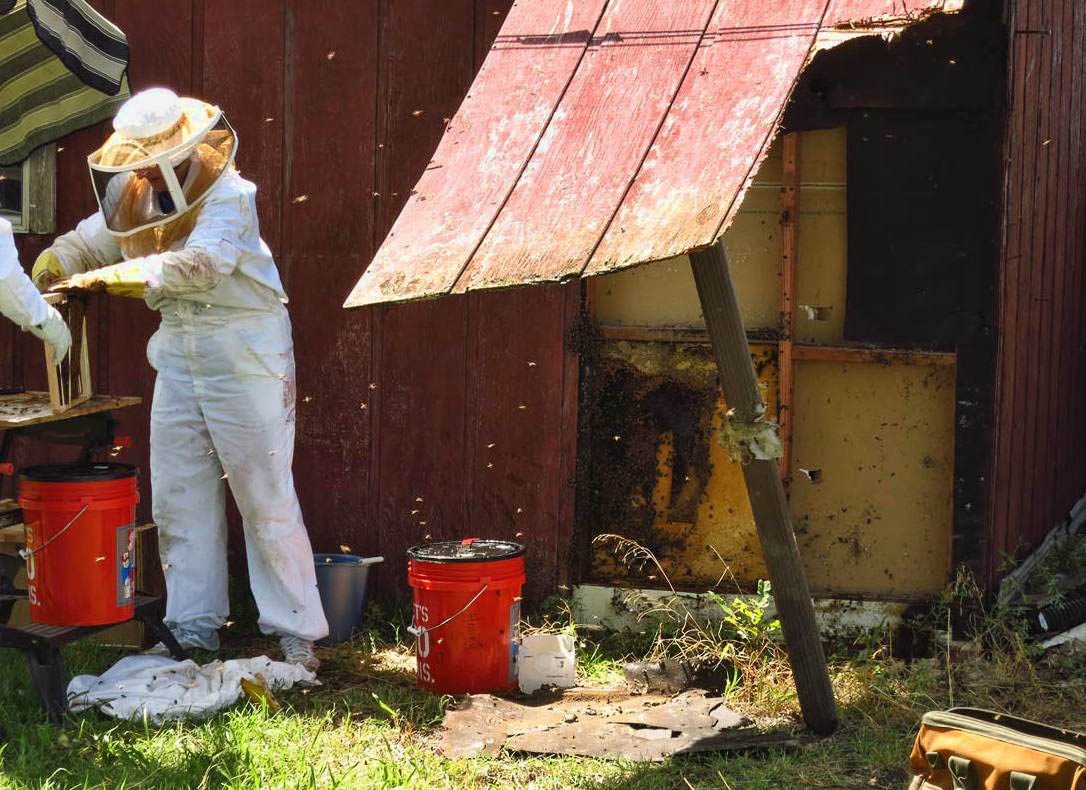
By sundown, the hive should have been “a beehive of activity” as all the bees return by nightfall. However, when Kim and Scotty returned to claim the hive box, there were only about 50 bees inside. There was quite a bit of dead larvae on the floor of the hive box, evidence that the bees had been “cleaning” the hive, an ongoing function performed by the workers.
The queen was still intact, so they decided to give it another day, in case the bees were just out foraging. But a buzzing sound could be heard emanating from overhead, so we traced the sound upward. The bees had swarmed, and were covering an entire branch of a tree overhead. Kim borrowed a ladder, climbed into the tree and slammed down the clump of bees into a 5 gallon bucket which she quickly covered, then dumped into the hive box. But the following day, there were only about five bees remaining in the hive box,including the queen, and the swarm had just moved further up the tree to an unreachable height.
As a last resort, Kim replaced the hive box with a new clean box with some honey for “bait” and repositioned the queen, still in her cage clip, along with four other bees. But they still refused to enter the hive. The bees were complacent in their swarm, a behavior that typically indicates their queen is with them. Bees won’t typically abscond, leaving their queen behind. So it was determined that either there were two hives in the wall, one on the outer side of the sheetrock and one on the inner side leaving a second queen, or the queen was aging.
As I stood in the back yard gazing up at the tree, wishing for Kim’s sake that the bees would fly home, I considered the metaphor to be not unlike my own life. Swarming around the perimeter, waiting out on a limb, refusing to be confined to a “box,” yet reluctant to fly off and leave my “queen.”
The next morning, the bees had taken flight, leaving the queen in her cage. Kim returned to claim the hive box, and will try to assimilate the queen into a new hive. She didn’t get the swarm she had hoped for, but she got the $100 donation for new equipment and a queen (value $30,) and there was lots of honey to be shared. And the bees got the freedom of flight…at least temporarily.




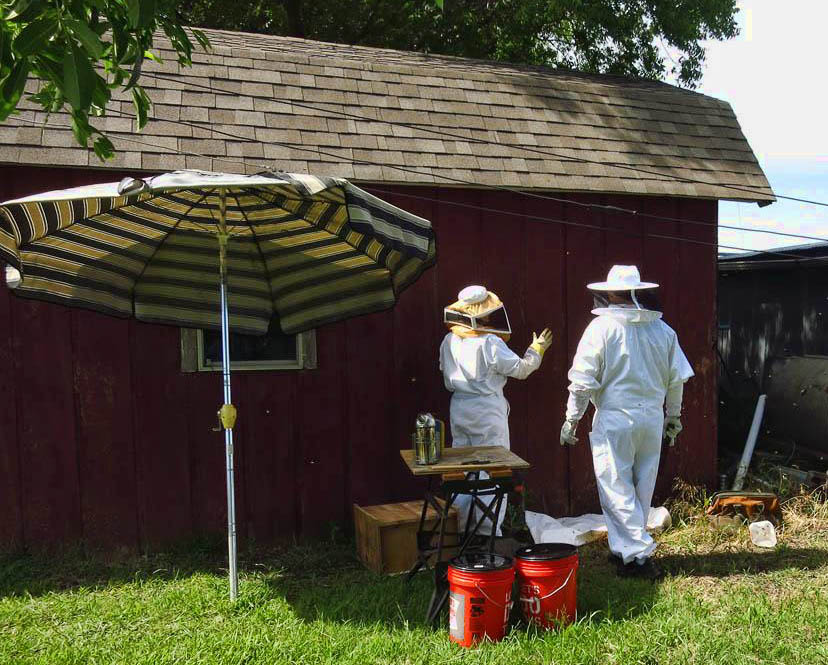

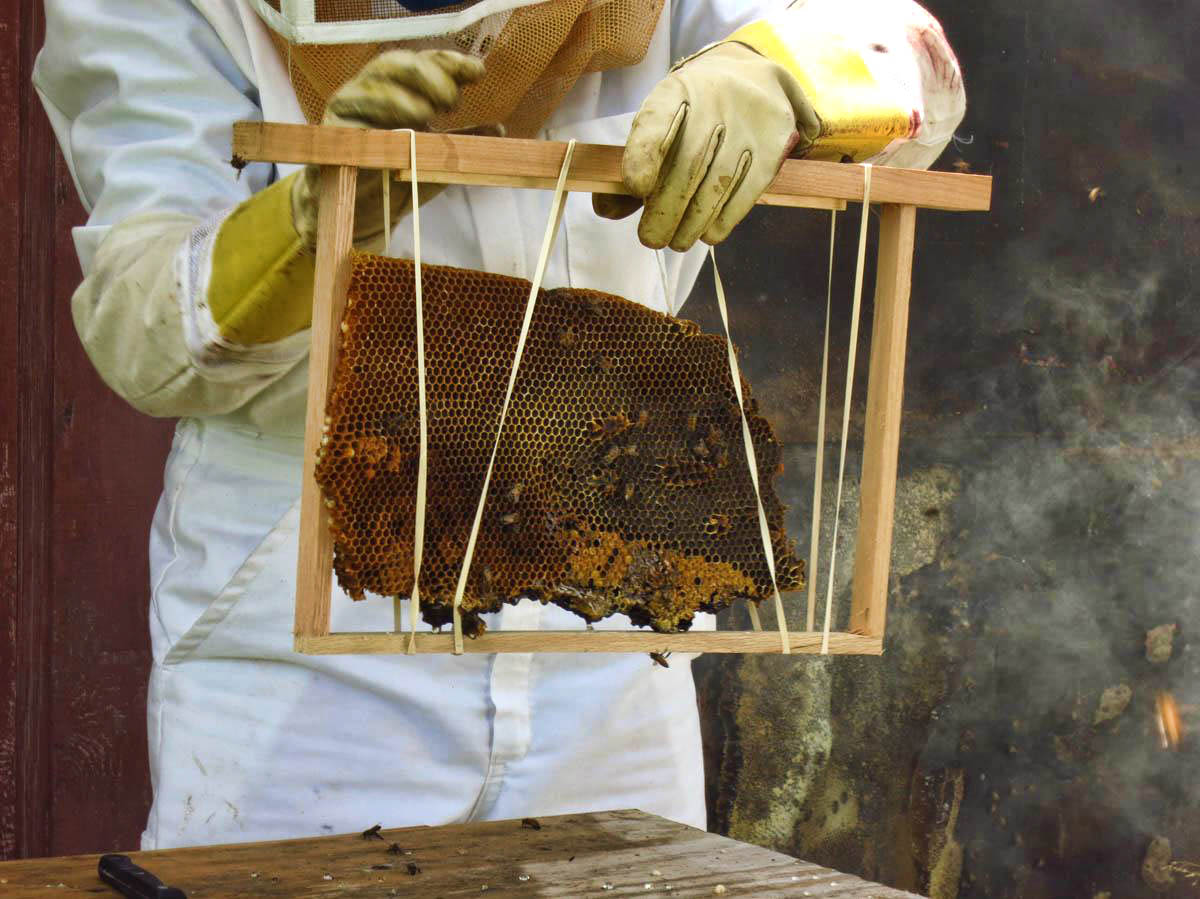




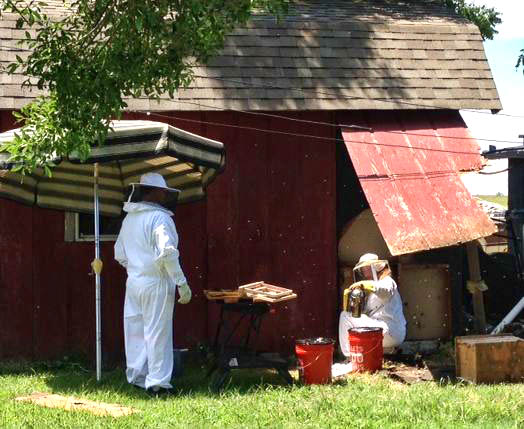

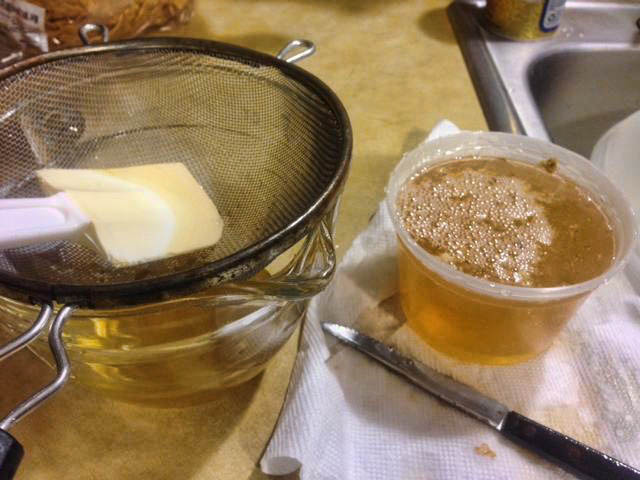
How very interesting! I’ve twice seen bees swarm on a bush as they were headed to a new location, and once as a whole group went whipping by us while we were out hiking, but this experience was quite different. If you still have a queen in the shed, maybe Kim will be able to coax them out at a later date.
Virtual hugs,
Judie
Hi, Judie — Sorry if i wasn’t more clear, but the shed is “bee free!” They took off from the tree, never to be seen again. I hated that Kim didn’t get to keep them, but just relieved that they are no longer a threat to Mom and Dad.
That was most interesting. Thanks for telling us about it.
With bees becoming so precious, and so threatened, it is great to read a story like this. Fascinating, no wonder you got caught up in it.
Bees are very important for those of us gardening, but it’s scary for a hive to be in a place they shouldn’t be. I hope it all works out relocating the hive! Stay safe, and enjoy that honey !!!
Interesting. Bees are just fascinating. I have friends who keep bees. Since I’m allergic that will never be a hobby for me. But their social structure is very cool.
I have a lot of respect for those who work with Bees. Your story was fascinating.
Really interesting. To be honest bees scare me and your poor Dad being stung like that must have been horrific. I can relate to the noise they make fanning the hive as I was once cycling along a lane next to a field full of hives and the noise was amazing. I didn’t hang around long. In the garden we have some bee “hotels”, made of short lenghts of bamboo, leaf cutter and masonry bees use them, but they are not aggressive and very rarely sting.
Fascinating.
So interesting! Thanks for relating the whole story. It was all new info to me.
Very interesting. My sister-in-law is a master gardener and has talked about getting involved with bees. Me? I’ll stay more than a safe distance away enjoying the bounty of fresh honey.
Very interesting post, Suzanne! We had a large, old tree come down at my parents farm years ago. I couldn’t get over the huge hive inside (which is why it finally broke apart because of the hollow center). The honey was old and dark and reminded me of molasses. It was so good but a not fun to strain. Glad you had the bee problem taken care of. Your poor dad!
The process was interesting (still wondering about the queen…is she selected at birth, does she work her way up, does she declare “I’m queen”…).
But my favorite is the metaphore – so true…
Makes my day to read your posts.
Linda — As I understand it, a queen can be raised from regular eggs. They just feed her the “royal jelly” which makes her larger in size. I believe they “groom” several eggs for a queen, and if more than one hatches at the same time, they will fight it out for the crown. It is a fascinating life cycle, indeed.
I’m sorry the bees didn’t “get with the program.” I guess they will fly to another area and start over? But happy that they are gone from your parents’ property. I’m curious about the honey you harvested. Was it delicious? Does it taste like the honey in stores? Such an interesting post! 🙂
Hi, Barbara — Nice to hear from you. Hope you and Katie are well. Yes, the honey was delicious! It was much lighter in color, texture, and taste than the honey I have purchased in stores. Very floral, but light.
Fascinating post Suzanne! I have always been interested in the life of honey bees. Thanks for the education! Sorry to hear that your friend didn’t get her swarm but glad that you don’t have to worry about your father getting stung again.
Fascinating! I knew zilch about bees…until now! I hope the honey is tasty!
Nice post on relocating bees. I had a swarm make a hive in my upper level of the house. I had the beekeeper out and watch him tear my house siding off to get at the Queen. Hope to see your in Ouray soon!
Really interesting Suzanne. I’m amazed you could find someone to come and get the hive. Excellent researching. So glad the hive didn’t have to be exterminated. Wish they had been wise enough to go with Kim and Scotty since who knows what may happen to them out swarming around. Bees are so important to us in ways far beyond honey. Glad your dad is safe.
Hi, Sherry — Thanks for stopping by. I have to give credit where credit is due, though….my older brother Don found Kim and Scotty. He had a trip planned for Mexico, so I just took over from him. But I really enjoyed the project!
Great story, experience and ending even if Kim didn’t get her bees.